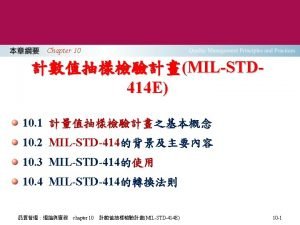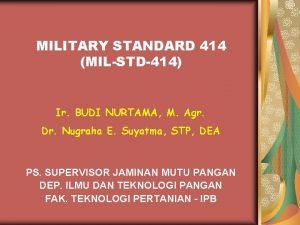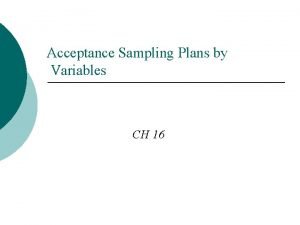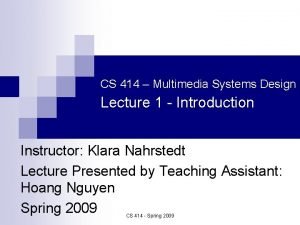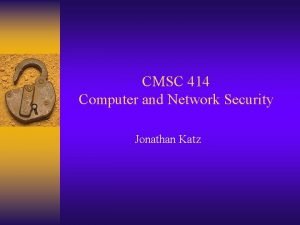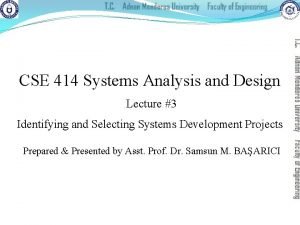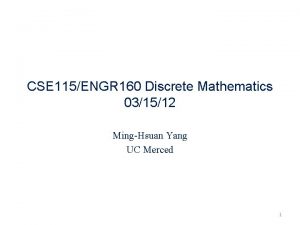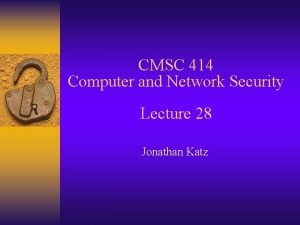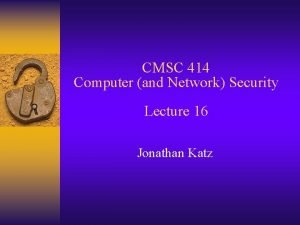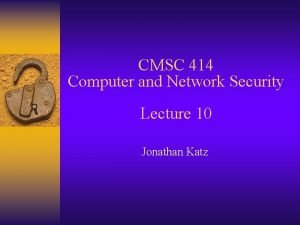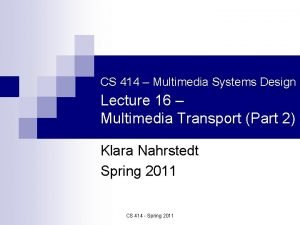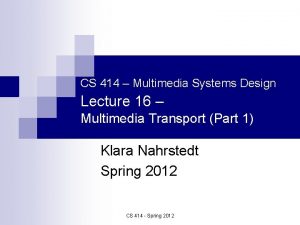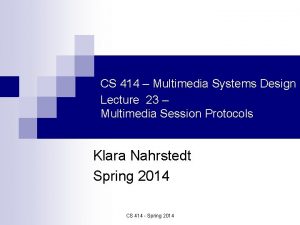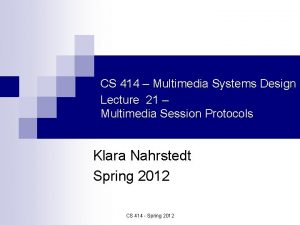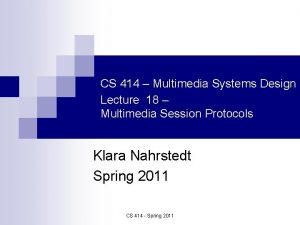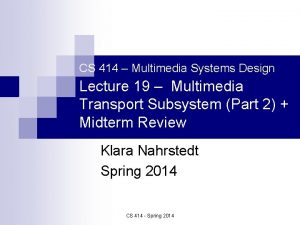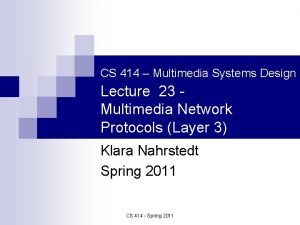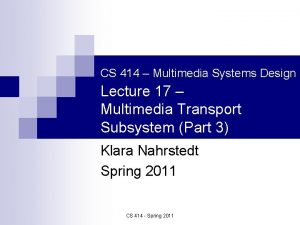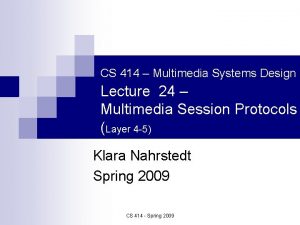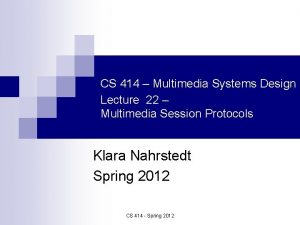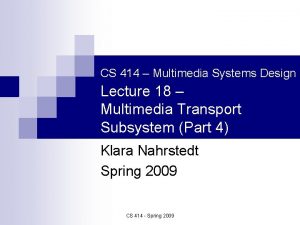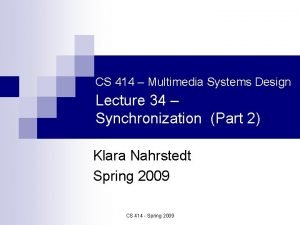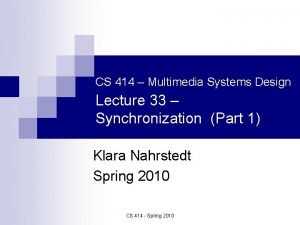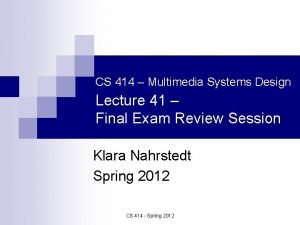CS 414 Multimedia Systems Design Lecture 20 Multimedia


















- Slides: 18

CS 414 – Multimedia Systems Design Lecture 20 – Multimedia Transport Subsystem (Part 3) Klara Nahrstedt Spring 2014 CS 414 - Spring 2014

Administrative MP 1, HW 1, Midterm grades should be in by Wednesday/Thursday this week n MP 2 posting by the end of this week n CS 414 - Spring 2014

Transmission Phase Multimedia Streaming Protocol n Classification of Packets/Frames ¨ Identification of packets/frames ¨ Marking of Packets/Frames n Queueing ¨ Rate Control ¨ Error Control n Policies to drive classification and queueing ¨ Shaping and policing CS 414 - Spring 2014

Packet/Frame Classification Identification of packets/frames in the network n Three types of identifications n ¨ Access n control lists IP address, port ¨ Application source classification Video streaming n Voice over IP n Call signaling n Best effort http traffic n ¨ Switch ports CS 414 - Spring 2014

Classification of Multimedia Sources n Strongly Regular vs Weakly Regular traffic Strongly regular stream – has packets of the same size (e. g. , audio stream) ¨ Weakly regular streams – has packets of different sizes within one stream (e. g. , MPEG stream) ¨ n Strongly Periodic vs Weakly Periodic traffic Strongly periodic stream – when periods between packets/frames within a stream are the same ¨ Weakly periodic stream – when periods between packets within one stream deviate by x time units ¨ n Isochronous vs Synchronous vs Asynchronous Traffic n n n Isochronous traffic – packets have end-to-end bound and jitter bound Synchronous traffic – packets have end-to-end bound, but no jitter bound Asynchronous traffic – don’t have any bounds CSpackets 414 - Spring 2014

Application Source Classification n Classification of sources : ¨ Data – bursty, weakly periodic, strongly regular ¨ Audio – continuous, strong periodic, strong regular ¨ Video – continuous, bursty due to compression, strong periodic, weakly regular n Classification of sources into two classes: ¨ Constant ¨ Variable Bit Rate (CBR) – audio Bit rate (VBR) – video, data CS 414 - Spring 2014

Marking of Packets n Marking is done close to source flow ¨ Get differentiated treatment ¨ E. g in Layer 3 IP headers ¨ Hardware-based Qo. S Marking at high-speeds to keep up with speed of switch CS 414 - Spring 2014

Policies – Traffic Shaping and Policing n n n In Packet Network, admission control, reservation is not sufficient to provide Qo. S guarantees Need traffic shaping at the entry to network and within network Traffic shaping algorithm ¨ Decides how packets will be sent into the network , hence regulates traffic ¨ Decides whether to accept a flow’s data ¨ Polices flows CS 414 - Spring 2014

Purpose of Traffic Shaping n Traffic shape ¨A way of a flow to describe its traffic to the network Based on traffic shape, network manager (s) can determine if flow should be admitted into the network n Given traffic shape, network manager(s) can periodically monitor flow’s traffic n CS 414 - Spring 2014

Example n If we want to transmit data of 100 Mbps, ¨ Traffic Shape A: Do we take 1 packet size of size 100 Mbit and send it once a second, or ¨ Traffic Shape B: Do we take 1 packet of size 1 Kbit and send it every 10 microseconds? A 1 Mbit Kth second K+1 th second B CS 414 - Spring 2014

Flow’s Traffic Shape Parameters (Network Qo. S) n Traffic Envelope ¨ Peak rate ¨ Average rate ¨ Burst length ¨ Burst duration n Service Envelope ¨ Maximum tolerable delay ¨ Desired delay jitter ¨ others CS 414 - Spring 2014

Bandwidth Allocation n CBR traffic (shape defined by peak rate) ¨ CBR source needs peak rate allocation of bandwidth for congestion-free transmission n VBR traffic (shape defined by average and peak rate) ¨ average rate can be small fraction of peak rate n n underutilization of resources can occur if pessimistic allocation (peak rate allocation) is applied Losses can occur if optimistic allocation (average rate allocation) is applied CS 414 - Spring 2014

Isochronous Traffic Shaping (Simple Leaky Bucket Traffic Shaper) n Developed by Jon Turner, 1986 (Washington University, St. Louis) CS 414 - Spring 2014

Example n Consider for audio flow, size of the bucket ¨ β = 16 Kbytes Packet size = 1 Kbytes (one can accumulate burst up to 16 packets in the bucket) ¨ Regulator’s rate ρ = 8 packets per second, or 8 KBps or 64 Kbps ¨ n Consider video flow, size of bucket ¨ β = 400 Kbytes ¨ Packet size = 40 Kbytes (burst of 10 packets) ¨ Regulator’s rate ρ = 5 packets per second, 200 KBps, 1600 Kbps CS 414 - Spring 2014

Isochronous Traffic Shaping (r, T)-smooth Traffic Shaper Developed by Golestani, 1990 n Part of stop-and-go queuing/scheduling algorithm n Traffic divided into T-bits frames, where T is fixed n r-bits packet size per flow is considered, where r varies on a per flow basis n CS 414 - Spring 2014

(r, T) Traffic Shaper T-bits frames, sent every T-bit times r-bits packets r≤T • Flow Time line is permitted to inject no more than r bits of data into the network frame in any T bit times • if the sender wants to send more than one packet of r-bits, it must wait for next T-bit frame. • A flow that obeys this rule has (r, T)-smooth traffic shape. CS 414 - Spring 2014

Comparison • It is relaxed from the simple leaky bucket traffic shaper because Rather than sending one packet of size c every 1/ρ time units, (in simple leaky bucket ) • The flow can send c*k bits every 1/ρ time units , where k is T-bits times within the period 1/ρ • 1/ρ K=2 CS 414 - Spring 2014

Conclusion Traffic Shaping happens at the entry to the network n It is a very important function to regular and police traffic at the edges to avoid huge bursts coming into the network n CS 414 - Spring 2014
 01:640:244 lecture notes - lecture 15: plat, idah, farad
01:640:244 lecture notes - lecture 15: plat, idah, farad Mil-std-414
Mil-std-414 Mil-std-414
Mil-std-414 Mil-std-414
Mil-std-414 Pc 414
Pc 414 Cs 414
Cs 414 Cmsc414 umd
Cmsc414 umd Cse414
Cse414 Gcd of 414 and 662
Gcd of 414 and 662 Cmsc 414
Cmsc 414 Cmsc 414
Cmsc 414 Cmsc 414
Cmsc 414 Advanced operating system notes
Advanced operating system notes Lecture sound systems
Lecture sound systems Lecture sound systems
Lecture sound systems Multimedia becomes interactive multimedia when
Multimedia becomes interactive multimedia when Disadvantages of multimedia
Disadvantages of multimedia Csc 253
Csc 253 Esa multimedia.esa.int./multimedia/virtual-tour-iss
Esa multimedia.esa.int./multimedia/virtual-tour-iss

